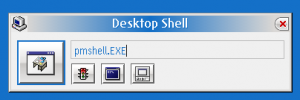ATSHELL: Difference between revisions
Jump to navigation
Jump to search
No edit summary |
No edit summary |
||
| Line 5: | Line 5: | ||
|Author=[[Alex Taylor]] | |Author=[[Alex Taylor]] | ||
|License=GNU GPL | |License=GNU GPL | ||
|Download= | |Download={{FileLink|ATSHELL_0-5.zip}} | ||
|Website=[http://www.altsan.org/programming/os2/#atshell Official Page] | |Website=[http://www.altsan.org/programming/os2/#atshell Official Page] | ||
}} | }} | ||
Revision as of 04:34, 20 July 2021
| ATSHELL | |
|---|---|

| |
| Version | 0.5 - 2006-12-09 |
| Vendor | |
| Author | Alex Taylor |
| License | GNU GPL |
| Download | ATSHELL_0-5.zip |
| Website | Official Page |
ATSHELL is a small program designed to replace PMSHELL.EXE as the OS/2 RUNWORKPLACE program. It allows an arbitrary program to be used as the 'desktop', including (but not limited to) the Workplace Shell (PMSHELL), a web browser, a file manager, or some custom application. It also allows this desktop program to be stopped and restarted, or even changed to something else entirely, without rebooting the system. In addition, ATSHELL allows you to open command prompts or shut down the system, even when the desktop program is not running.
ATSHELL supports the following optional command-line parameters:
- /Q
- This causes the desktop shell to be launched immediately when ATSHELL first starts up, without displaying the ATSHELL dialog. (The ATSHELL dialog will appear, however, when/if you close the desktop shell program.)
- /S
- This enables a simple 'secure' mode. When ATSHELL is started with this parameter, the command prompt and configuration options are disabled and inaccessible. USE THIS OPTION WITH CAUTION -- if you don't have an alternative method of booting (such as boot diskettes or a maintenance partition), you won't have any way of changing the configuration (or even removing ATSHELL from CONFIG.SYS), unless the desktop (or startup) program itself gives you access to a command prompt. Alternatively, you can use this in conjunction with the multi-user local logon feature of Security/2, by setting 'atshell /s' as the local shell for non-privileged users, and keeping the WPS (or something else) for the system administrator.